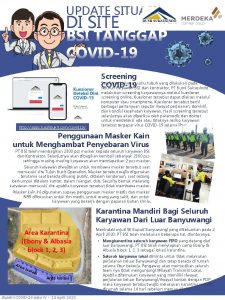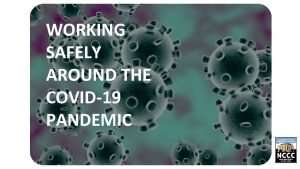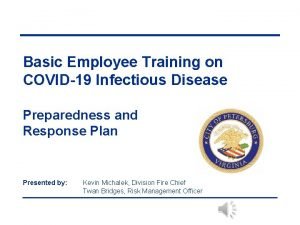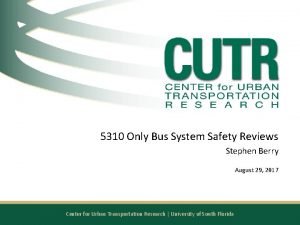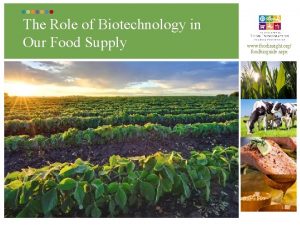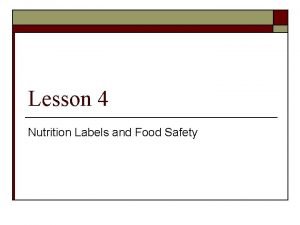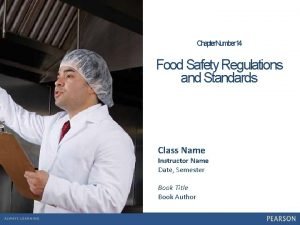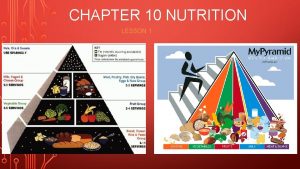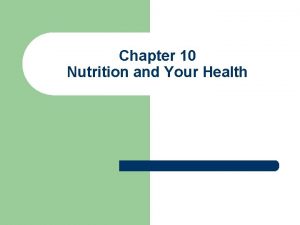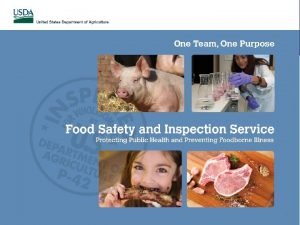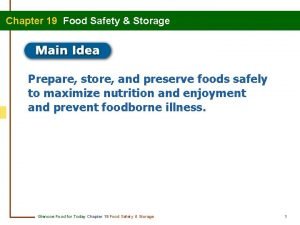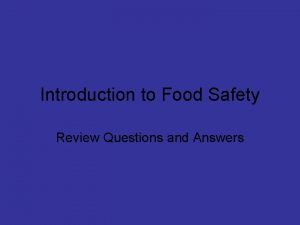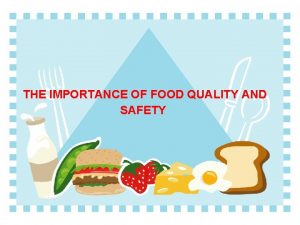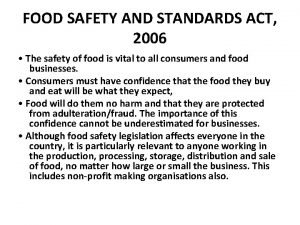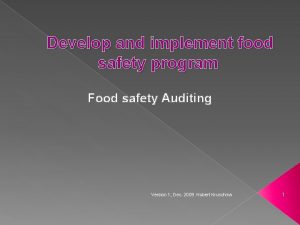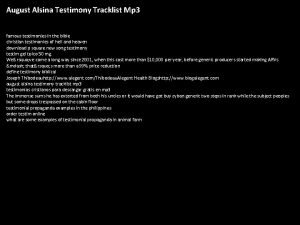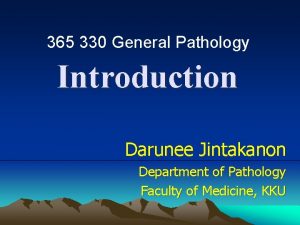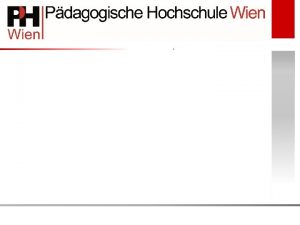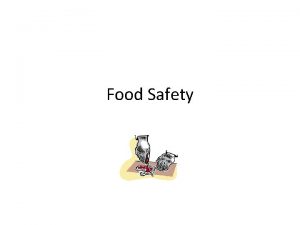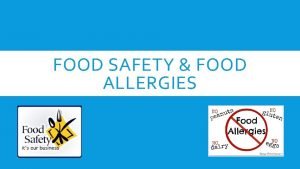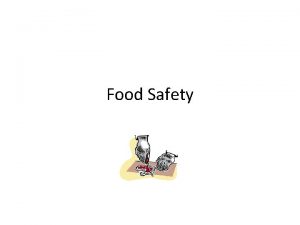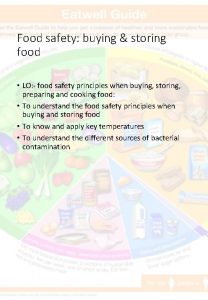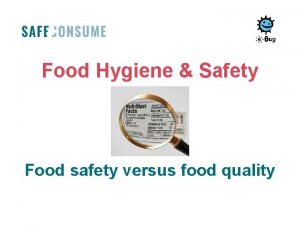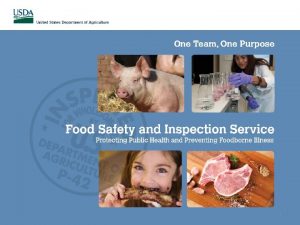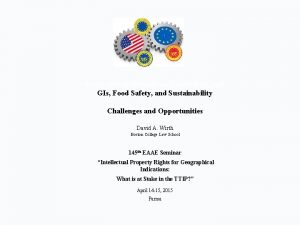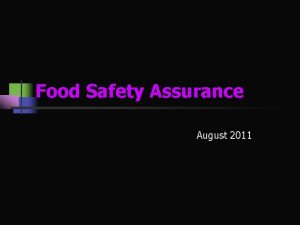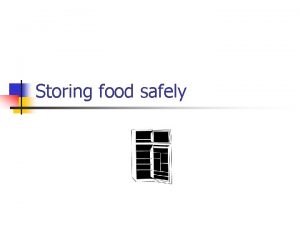COVID19 and Food Safety Darunee Edwards 5 August









































- Slides: 41

COVID-19 and Food Safety Darunee Edwards 5 August 2020

Local Wisdom in Selection of Food Ingredients

Novel Corona Virus, COVID-19 • • • New type of respiratory virus No previously known knowledge No vaccine No medication Airborne and spreads rapidly High mortality rate 1/3

Novel Corona Virus, COVID-19 2/3 • • Worldwide pandemic Panic nationally and internationally National emergency Thailand lock down situation: Quarantine Working from home Schools closed down Close sight seeing areas, catering services, sport complex, etc. – No party, no sale of alcohol, no festival, no get together event, no exhibition, no meeting, no training – No airline operation – –

Novel Corona Virus, COVID-19 3/3 • World poverty and hunger worsening with the coronavirus pandemic, WHO • Airborne and spread from person to person • Some people without symptoms but may be able to spread the virus, incubation period 5 -14 days • Disease turns to affect not just lungs, but kidneys, heart and circulatory system and senses of smell and taste • Recovery may cause severe health impacts • Currently, no evidence of food, food containers, or food packaging being associated with transmission of COVID-19 • Strict hygienic practices of food handler is necessary

Impact of COVID-19 • • • World and national economies are badly affected National emergency decree Broken supply chains No travelling, no tourism Dramatic reduction in export and import of goods Loss of businesses: hotel, tourism industry, food service, transport businesses, food supply chain Loss of jobs Family relations disastrous High national expenditure in hospital treatment Hospital treatment facilities not sufficient Panic buying of consumer goods, emergency restocking

Impact of COVID-19 • • • Consumer get panic Emergency restocking Grocery over crowded Some opportunist businesses and gov authorities Loss of job, no money and lots of debt Buy less and eat less No free lunch for school students Parents in trouble of purchasing food for family New channels for food delivery

Food Loss Food Waste Population Increase Increasing Affluence Energy Crisis Regulatory Framework COVID-19 Economic Crises Global Crisis Affecting Food Security Depreciation of Natural Resources Urbanization Aging/Aged society Climate Change Labor Trafficking

Importance of Food Business in Thailand • Agriculture-based nation involved vast number of poputation • Value creation from agri-produce • Food innovation, more varieties of foods • Control of food safety and food quality • Healthy society • Wealthy society • Food security and health security • Job creation • Tourism

Food Value Chain Consumer/ market Consumer / Market Transportation Packaging Plant/Animal breed Transportation Processing Packaging Food Supply Chain Management Farming system (GAP/Co. C) Harvest Farming Breed Manufacturing (GMP/HACCP) Pre-harvest & Post-harvest

Why food not safe!-1/3 Food can become unsafe due to several reasons Emerging foodborne illnesses problems Change in pathogens through adaptation by natural selection Dietary habits of preference and practices and cultural beliefs may be the causes Food trade of plant and animal origin is increasing rapidly and contributed to the spread of foodborne problems to new areas

Why food not safe!-2/3 Food can become unsafe due to several reasons Economic and technical development of new food, new production system or new environmental changes increase opportunities for contamination due to lack of knowledge from food handlers and an increase in mass catering Poverty and pollution, environmental contamination Poor social conditions and lack of safe food preparation facilities

Why food not safe!-3/3 Food can become unsafe due to several reasons Travel and migration of millions of people crossing borders can spread diseases rapidly to new environment Poor hygiene practice of food handlers of street food and the improper storage of raw ingredients esp. meat and seafood items Inappropriate time and temperature in processing Improper cleaning and sanitizing Contamination and cross contamination

Food Safety and Quality o Food safety is a global issue o Consumption of wholesome foods, good quality and safety and right nutrition is one of the basic human rights

Why food safety is a must for any food enterprise? Consequence of producing unintentionally or intentionally unsafe food: • consumer gets sick • Government authority intervene in this incident • Ruin business and may end up with bankruptcy • Ruin national reputation if it is a serious incident

Food safety and quality management system Ø Food safety is an extreme important tool for any food enterprise! Ø Food quality and safety management system is a preventive tool, it is to reduce chance of producing poor or lower than standard food! Ø Well trained staff is key to achieve the goal of producing safe food!

Benefits of Food Safety and Quality Management System Ø Processing of safer food >> lower business risk Ø Clients satisfaction >> reputation and brand value Ø Staff knowledge and skill >> better productivity Ø Less production cost >> less utilities expense, less waste, less error Ø More business opportunities Ø Higher profitability Ø Compliance with national and international regulations

FAO (Food and Agriculture Organisation) FAO provides guidelines and food standards on food safety and quality as part of their effort towards food security, to ensure 1. Food availability 2. 3. Food accessibility 4. Stability Utilization

WHO (World Health Organisation) “Foodborne diseases take a major toll on health. Millions of people fall ill and many die as a result of eating unsafe food” WHO Member States adopted a resolution in 2000 declaring food safety as an integral part of public health consideration

Codex Alimentarius Jointly established in 1963 by FAO (Food and Agriculture Organization) WHO (World Health Organization) 189 member countries Main objectives to promote a science-based approach in setting food standards to improve multi-stakeholder dialogue on establishing standards, guidelines and code of practices to adopt food standards by all member countries

Food Safety Management System ISO 22000 Private Standard: ISO 9000+HACCP+GMP Food Safety Management system HACCP GMP Primary GMP +5 S Codex Guideline Thai : to be mandatory Codex Guideline Thai : mandatory since 2000 General Practices Thai: mandatory 2014

Good Manufacturing Practice GMP or Good Hygienic Practice (GHP) or Primary GMP: Ø prerequisite program Ø basic environmental & operating conditions Ø production of safe and quality food Ø compliance with regulations

Good Manufacturing Practices Codex GMP - for food manufacturing 1. 2. Primary production 3. 4. Control of operation Establishment: design and facilities Establishment: maintenance and sanitation Primary GMP-for microenterprise. 1 Location and manufacturing buildings. 2 Tools, machineries and production equipment. 3 Control of production process 5. 6. Transportation . 4 Sanitation 7. Production information and . 5 Cleaning and maintenance Establishment: personal hygiene consumer awareness 8. Training . 6 Personnel and hygiene workers

Hazard Analysis and Critical Control Points HACCP: Benefits effective method of maximizing food safety applicable thru out food chain: farm to fork reducing risk of selling unsafe products enhance product quality and safety

HACCP System Pre-requisite Program (GMP) pest control, cleaning procedures, hygienic practices Preliminary Procedures (5 tasks) HACCP Principles (7 principles) Training

HACCP System Preliminary Procedures 1. Assemble HACCP team 2. Describe product 3. Identify intended use 4. Construct flow diagram 5. On-site confirmation of flow diagram

HACCP System Principles of the HACCP system 1. Conduct a hazard analysis 2. Determine the Critical Control Points (CCP) 3. Establish Critical Limits 4. Establish a system to monitor control of the CCP 5. Establish the Corrective Actions to be taken when monitoring indicates a particular CCP in not under control 6. Establish procedure for Verification to confirm that HACCP system is working effectively 7. Establish Documentation concerning all procedures and Records appropriate to these principles and their application

Hazards in Foods There are 3 categories • Physical hazards e. g. metal, glass, bone, sharp objects • Chemical hazards e. g. pesticides, toxins, chemical misuse, chemical reaction during storage, heavy metals • Biological hazards e. g. contamination of pathogenic bacteria, yeast, mold, virus, parasite

Food Hazards -1 1. Physical hazards broken glasses extraneous matters pin pieces of metal etc. Consequence: injuries

Food Hazards-2 2. Chemical hazards misuse of food additives vet drug residue heavy metal residues fertilizer contamination mycotoxin pollutants antibiotic residues products from chemical reaction: rancidity, browning Consequence: lead to acute symptoms or chronic effects due to accumulation of harmful substances in the body

Food Hazards-3 3. Microbiological hazards pathogenic bacteria mold infection virus parasites etc. Consequence: poisoning and infection with diarrhea, vomit, headache, numb, kidney failure

Foodborne Illness • Caused by consumption of food containing pathogens such as virus, bacteria, mold, yeast, parasite, biotoxin or poisonous chemicals • Major health problem world wide • Most illness cases are mild but some severe cases in vulnerable groups can be morbidity and mortality • Difficult to investigate and to trace the exact mortality associated with foodborne illnesses

Some Foodborne Pathogens Viral Agents • Norovirus • Hepatitis A • Hepatitis E • Adenovirus Enterix • Rotaviruses Parasitic Agents • Cryptosporidium sp. • Cyclospora cayetanensis • Giardia lamblia • Entamoeba histolytica Bacterial agents • Listeria monocytogenes • Staphylococcus aureus • Bacillus cereus • Campylobacter jejuni • Clostridium botulinum • Clostridium perfringens • Clostridium difficile • Salmonella spp • Shigella spp • Escherichia coli 0157: H 7 • Yersinia enterocolitica • Brucella spp • Vibrio cholerae

Foodborne Disease Outbreak • When 2 or more people get the same illness from the same contaminated food or drink • 4 most world wide problematic foodborne pathogens: o o Salmonella enterica Listeria monocytogenes Campylobacter jejuni E. coli 0157: H 7

Outbreak: Salmonella Infection Japan, 2011 • Product: Miso soup with potatoes, green salad and radish with minced chicken, rice and milk • From: Central Kitchen • 1, 048 school students, teachers and staff from 9 schools infected with severe diarrhea, 13 students hospitalized, • Food safety and hygienic practices stringently introduced

Outbreak: Shiga toxin-producing E. coli 0157: H 7 USA. , 2012 Product: Organic Spinach and Spring Mix Blend From: State Garden 32 people infected, 12 people hospitalized, 9 people developed hemolytic uremic syndrome or a type of kidney failure • Product recall introduced • • •

Outbreak: Campylobacter jejuni USA. , 2014 Product: Raw Milk From: local establishment 99 people infected with diarrhea, abdominal pain and fever, 10 people hospitalized, 1 died • Closed down the establishment • • •

Outbreak: Listeria monocytogenes Listeriosis USA. , 2015 • Product: Packaged Mix Vegetable • From: Dole • 19 people hospitalized with fever, diarrhea, muscle aches, head aches, 1 case died • Product recall introduced and closed down this line of product

Outbreak: Shiga toxin-producing E. coli 0157: H 7 USA. , 2016 Product: ground beef, veal From: Adams Farm Slaughterhouse 11 people infected, 7 people hospitalized, 1 case developed hemolytic uremic syndrome or a type of kidney failure • Product recall introduced • • •

Action needed during COVID-19 • Prompt communication about risk from COVID-19 is a must • Need to provide concise and clear awareness of preventive measure from contamination, without scaring population • There is no concern food safety, but hygienic practices needs to be strengthened • The development of vaccines and medicines

Thank You
 Http//apps.tujuhbukit.com/covid19
Http//apps.tujuhbukit.com/covid19 Do if you covid19
Do if you covid19 Covid19 athome rapid what know
Covid19 athome rapid what know What do if test positive covid19
What do if test positive covid19 Vaksin covid19
Vaksin covid19 August safety topics
August safety topics August safety
August safety What is food safety
What is food safety Unit 2 food food food
Unit 2 food food food Grazing food chain diagram
Grazing food chain diagram January february march april
January february march april Biotechnology and food safety
Biotechnology and food safety Lesson 4 nutrition labels and food safety
Lesson 4 nutrition labels and food safety Food safety regulations and standards
Food safety regulations and standards Chapter 10: nutrition for health lesson 1 answer key
Chapter 10: nutrition for health lesson 1 answer key Chapter 10 lesson 4 nutrition labels and food safety
Chapter 10 lesson 4 nutrition labels and food safety Food safety and inspection service definition
Food safety and inspection service definition Chapter 19 food safety and storage
Chapter 19 food safety and storage Food safety questions and answers
Food safety questions and answers Importance of quality food
Importance of quality food Food safety and standards act,2006
Food safety and standards act,2006 Significance of the study example
Significance of the study example Food safety and toxicology
Food safety and toxicology Develop and implement a food safety program
Develop and implement a food safety program Catzoc ecdis definition
Catzoc ecdis definition Safety care certification
Safety care certification Personal safety vs process safety
Personal safety vs process safety Safety assessment for ind safety reporting
Safety assessment for ind safety reporting Basic safety orientation
Basic safety orientation 00101-15 basic safety
00101-15 basic safety Do que miranda amiga de via chamava august
Do que miranda amiga de via chamava august Julie august
Julie august It was late summer 26 august 1910
It was late summer 26 august 1910 What is troy maxson job and how is it symbolic
What is troy maxson job and how is it symbolic Aug 1891 el filibusterismo
Aug 1891 el filibusterismo De leerexpert august leyweg 4
De leerexpert august leyweg 4 August strindberg giftas
August strindberg giftas Gailit romaanid
Gailit romaanid August alsina testimony album zip download
August alsina testimony album zip download Three august ones
Three august ones August robert ludwig macke
August robert ludwig macke Full moon august 2011
Full moon august 2011
